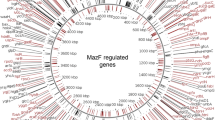Summary
Three novel fim genes of Escherichia coli, fimF, fimG and fimH, were characterized. These genes were not necessary for the production of fimbriae but were shown to be involved in the adhesive property and longitudinal regulation of these structures. Complementation experiments indicated that both the major fimbrial subunit gene, fimA, and the fimH gene in combination with either the fimF or the fimG gene were required for mannose-specific adhesion. The fimF, fimG and fimH gene products were likewise shown to play a major role in the fimbrial morphology as longitudinal modulators. The amount of FimF, FimG and FimH proteins appeared to control the length and number of the fimbriae. The DNA sequence of a 2050 bp region containing the three genes was determined. The corresponding protein sequences all exhibited homology with the fimbrial subunit protein, FimA.
Similar content being viewed by others
References
Abraham JM, Freitag CS, Clements JR, Eisenstein BI (1985) An invertible element of DNA controls phase variation of type 1 fimbriae of Escherichia coli. Proc Natl Acad Sci USA 82:5724–5727
Adler HI, Fisher WD, Cohen A, Hardigree AA (1967) Miniature Escherichi coli cells deficient in DNA. Proc Natl Acad Sci USA 57:321–326
Boyer HW, Roulland-Dussoix D (1969) A complementation analysis of the restriction and modification of DNA in Escherichia coli. J Mol Biol 41:459–472
Holmes DS, Quigley M (1981) A rapid boiling method for the preparation of bacterial plasmids. Anal Biochem 114:193–197
Klemm P (1984) The fimA gene encoding the type 1 fimbrial subunit of Escherichia coli: nucleotide sequence and primary structure of the protein. Eur J Biochem 143:395–399
Klemm P (1985) Fimbrial adhesins of Escherichia coli. Rev Infect Dis 7:321–339
Klemm P (1986) Two regulatory fim genes, fimB and fimE, control the phase variation of type 1 fimbriae in Escherichia coli. EMBO J 5:1389–1393
Klemm P, Jørgensen BJ, van Die I, de Ree H, Bergmans H (1985) The fim genes responsible for synthesis of type 1 fimbriae in Escherichia coli, cloning and genetic organization. Mol Gen Genet 199:410–414
Lindberg FP, Lund B, Normark S (1984) Genes of pyelonephritogenic E. coli required for digalactoside-specific agglutination of human cells. EMBO J 3:1167–1173
Lindberg FP, Lund B, Normark S (1986) Gene products specifying adhesion of uropathogenic Escherichia coli are minor components of pili. Proc Natl Acad Sci USA 83:1891–1895
Maniatis T, Fritsch EF, Sambrook J (1982) Molecular cloning, a laboratory manual. Cold Spring Harbor Laboratory Press, NY
Maurer L, Orndorff P (1985) A new locus pilE, required for the binding of type 1 piliated Escherichia coli to erythrocytes. FEMS Microbiol Lett 30:59–66
Maxam AM, Gilbert W (1980) Sequencing end-labeled DNA with base-specific chemical cleavages. Methods Enzymol 65:499–560
Minion FC, Abraham SN, Beachey EH, Goguen JD (1986) The genetic determinant of adhesive function in type 1 fimbriae of Escherichia coli is distinct from the gene encoding the fimbrial subunit. J Bacteriol 165:1033–1036
Mooi FR, de Graaf FK (1985) Molecular biology of fimbriae of enterotoxigenic Escherichia coli. Curr Top Microbiol Immunol 118:119–138
Norgren M, Normark S, Lark D, O'Hanley P, Schoolnik G, Falkow S, Svanborg-Edén C, Båga M, Uhlin BE (1984) Mutations in E. coli cistrons affecting adhesion to human cells do not abolish Pap pili fiber formation. EMBO J 3:1159–1165
Oliver D (1985) Protein secretion in Escherichia coli. Annu Rev Microbiol 39:615–648
Orndorff PE, Falkow S (1984) Organization and expression of genes responsible for type 1 piliation in Escherichia coli. J Bacteriol 159:736–744
Salit IE, Gotschlich EC (1977) Type 1 Escherichia coli pili: characterization of binding to monkey kidney cells. J Exp Med 146:1169–1181
Sweeney G, Freer J (1979) Location of binding sites on common type 1 fimbriae from Escherichia coli. J Gen Microbiol 112:321–328
Thomson R, Achtman M (1978) The control region of the F factor DNA transfer cistrons: restriction mapping and DNA cloning. Mol Gen Genet 165:295–304
Volckaert G, de Vleeschouwer E, Blöcker H, Frank R (1984) A novel type of cloning vectors for ultrarapid chemical degradation sequencing of DNA. Gene Anal Techn 1:52–59
von Heijne G (1983) Patterns of amino acids near signal sequence cleavage sites. Eur J Biochem 133:17–21
von Meyenburg K, Hansen FG, Nielsen LD, Rise E (1978) Origin of replication, oriC, of the Escherichia coli chromosome on specialized transducing phages λasn. Mol Gen Genet 160:287–295
Author information
Authors and Affiliations
Additional information
Communicated by J. Lengeler
Rights and permissions
About this article
Cite this article
Klemm, P., Christiansen, G. Three fim genes required for the regulation of length and mediation of adhesion of Escherichia coli type 1 fimbriae. Mol Gen Genet 208, 439–445 (1987). https://doi.org/10.1007/BF00328136
Received:
Issue Date:
DOI: https://doi.org/10.1007/BF00328136




